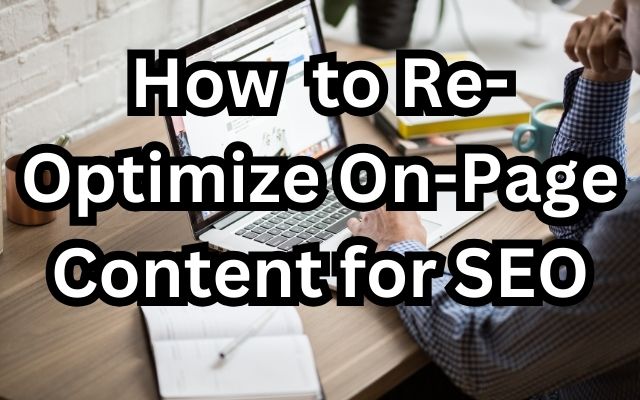Are you searching for How to Re-Optimize On-Page Content for SEO? In the ever-evolving world of Search Engine Optimization (SEO), setting it and forgetting it just won’t cut it. SEO strategies change and adapt, and your website and its content must change along with them to continue resonating with your target audience. To make these changes effectively, you first need to analyze your data and figure out what’s working and what isn’t.
The Importance of Data Analysis
Before diving into content re-optimization, you need to gather data to understand how well your content is performing in organic searches. You can use various tools for this purpose:
Google Search Console: This tool helps you track search queries to your site, monitor specific content pages, and check your website’s indexing status.
Google Analytics: It provides insights into your web traffic, user behavior, and conversions, giving you a deeper understanding of your audience’s actions.
Semrush or Moz: These tracking tools help you monitor specific keywords and analyze those targeted by your competitors.
By using these tools, you can build a clear picture of what’s performing well and what isn’t. This information will guide your re-optimization efforts.
SEO Re-Optimization When You’re Not Seeing Desired Results
If your SEO strategy isn’t yielding the results you want, it’s time to reassess some key aspects:
Are You Targeting the Right Keywords?
Ensure you’re focusing on the right keywords. Long-tail keyword phrases that precisely match your page’s topic and can compete on the search engine results page (SERP) are essential. Conduct a competitive keyword analysis using tools like Google Keyword Planner and Semrush to understand what content is ranking well for your target keywords. Analyze your competitors’ content and structure to see how your content compares and where you can offer more value.
Does Your Content Match User Intent?
User intent is vital, especially with Google’s recent core updates emphasizing the importance of content aligning with audience expectations. Google’s E-A-T (Expertise, Authoritativeness, Trustworthiness) framework guides content creators in satisfying user intent. Focus on creating content that not only adheres to the E-A-T principles but also meets user expectations, improving your search rankings and attracting more traffic.
SEO Re-Optimization When You’re Seeing Positive Results
When your SEO strategy is working well and you’re witnessing improvements, it’s not time to hit the brakes. Consistent content improvement is key to maintaining your position. Small yet meaningful updates show search bots that your content remains relevant and ensures your audience receives helpful and reliable information.
Focus on four crucial elements for continual improvements:
- Clarity: Make your content’s intent clear and strategically place keywords throughout the page, ensuring they enhance, not overpower, the content.
- Conciseness: Keep your content concise, delivering value to your readers quickly.
- Compelling: Present visually appealing content that is easy to access, making it engaging and memorable.
- Competitive: Stay ahead of the competition by providing more comprehensive or detailed information. Find your unique value and authenticity to stand out.
Outpacing the Competition
To differentiate your content and stand out from the competition, focus on providing more comprehensive or unique information. Offer complete, engaging, and valuable insights. Consider presenting data through charts, graphs, statistics, or lists, catering to different audience preferences. Show empathy for your audience and passion for your topic.
Keep your content authentic, in line with your brand, and relatable to your audience. Address their needs and questions with a tone and format that resonate with them. By crafting content that genuinely caters to your audience’s needs, you establish your website as a reliable resource.
FAQ
Q1: What is content re-optimization in SEO?
A1: Content re-optimization in SEO is the process of updating and improving your website’s content to make it more relevant, clear, and engaging for your target audience. It’s a way to keep your content fresh and effective in the ever-changing world of search engine optimization.
Q2: Why do I need to re-optimize my content?
A2: SEO strategies and user expectations evolve over time. By re-optimizing your content, you ensure that it continues to meet the needs of your audience and performs well in organic search results.
Q3: How do I know which content to re-optimize?
A3: You should start by analyzing data from tools like Google Search Console, Google Analytics, Semrush, or Moz. This data will help you identify which pages are not performing well and need improvement.
Q4: What if my SEO strategy isn’t getting the desired results?
A4: If your SEO strategy isn’t working as expected, you should first check if you’re targeting the right keywords. Make sure your keywords are specific and relevant to your content. Also, ensure that your content aligns with user intent, providing value and relevance to your audience.
Q5: What if my SEO strategy is working well and I’m seeing positive results?
A5: Even if your SEO strategy is successful, don’t stop there. Continuous content improvement is crucial. Focus on making your content clear, concise, compelling, and competitive to maintain and improve your search rankings.
Q6: How can I stand out from the competition in SEO?
A6: To stand out from the competition, offer more comprehensive or unique information. Find your unique value and authenticity, and present data or insights in a way that sets you apart. Ensure that your content resonates with your audience, and always strive to provide what they truly need in a format they prefer.
Also read: How to Easily Organize Your Inbox by Sorting Emails by Sender
Conclusion
Content re-optimization is a vital part of SEO. Always begin with data analysis, identify what needs improvement, and apply the principles of clarity, conciseness, compelling presentation, and competitiveness to your updates. By doing so, you’ll keep your content fresh and effective, driving better SEO results.
